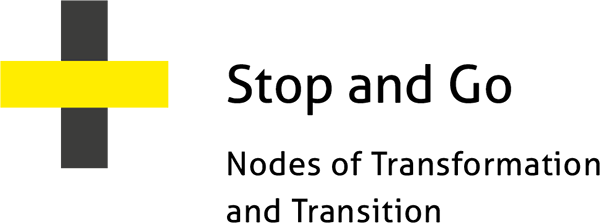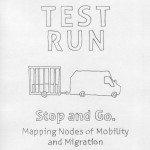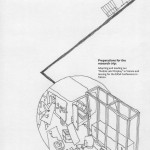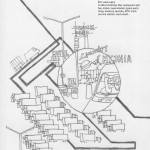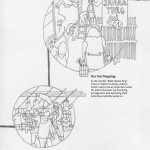Nodes and hubs alongside major traffic corridors, where traffic comes to a halt and exchange between actors en route happens, represent new forms of urbanity and public space, sites where both individuals’ routes, routines, and rituals and political transitions and urban transformations can be explored.
When increasing numbers of people are obliged to spend increasing amounts of time in transit, transition nodes, hubs, and terminals along their primary route – where exchange between the actors happens en route – acquire ever-greater significance. If we follow Henri Lefebvre’s thesis that urbanity is no longer defined by density but by the degree of difference performed at specific places, then these nodes paradigmatically represent new forms of urbanity and public space. In preceding projects such nodes have been investigated as single socio-spatial entities. In contrast, we also emphasize these nodes as polyrhythmic ensembles (Crang 2001, Edensor 2010), shrinking and growing linked to their temporal adaptability – reacting to daily, weekly, and seasonal rhythms of traffic flows – and their interdependence on one another in a wider regional or even transnational network of such nodes.
We saw this conference as an opportunity to present the theoretical framework and methods developed in the course of our preceding art-based research projects, focusing on nodes of mobility and migration as well as the concept of our current project: comparing three nodes arranged in the triangle of Vienna (AT) – Rouse (BG) – Tallinn (EST). Furthermore, we decided to employ our journey between Vienna and Tallinn as a test run to try our research methods and tools in the field. With a transporter van that also serves as a mobile laboratory and by compiling/storing artistic artifacts, comics, and maps – each of which represent preliminary research to trigger episodic in-situ interviews – we wanted to generate different forms of knowledge that will later be transformed into large-scale art installations on site. The goal of the whole project is to develop a networked “cartography” of hubs and routes that displays both supranational developments and individual experiences of mobile actors as well as the impact of both on urban transformations.
Test-Mapping at the “Balti Jaama Turg” (Russian Market) – Involving Actors on Site
Interestingly, our Tallinn-based research partner Tarmo Pikner initially wanted to draw our attention to the market. It seems to be an acknowledged popular attraction and hotspot for international tourists, even making it to first place on The Guardian’s list of “Top 10 Cultural Must-Sees in Tallinn”. We were not surprised to meet other conference participants at the market, including a man with a bike and an action-cam fixed onto the handlebars.
In the early 1990s, after the fall of the Iron Curtain, a market was established next to Tallinn’s main train station. It is a fenced-in market visited especially by Estonians with an ethnic Russian background and by Russian post-perestroika immigrants. But also many people living in the city district go to the market to purchase fresh vegetables and fruits. The market will be redesigned and upgraded following the gentrification of the surrounding areas: the residential areas of Kalamaja and Pelgulinn, famous for their smaller-scale wooden houses, and the former industrial area of Telliskivi, now a creative industries hub and fancy hang-out being discovered by artists, architects, academics, and hipsters of all sorts. And, as in other similar contexts, there are already some young scholars, activists, and urban designers committed to “saving” the market from investors’ plans. Members of the neighborhood union (Telliskivi Selts) have made several efforts to promote the special values of the existing market’s atmosphere, which should survive the future redesign. An anthropologist from Spain, who studied in Russia for one year before moving to Tallinn, even wrote his PhD on post-socialist urban transformation using this market as one of the case studies! He also made a participatory exhibition at the Academy of Fine Arts, asking friends to purchase items on the market and to illustrate their history and part of their vendors’ biographies.
Over the course of the EASA conference, we chose two afternoons upon which to park our vehicle between the main entrance to the market and the pedestrian walkway leading to the train station. This area is frequented by many people, giving us the opportunity to attract attention and raise the interest of passersby with the aim of gaining participants for short interviews. The goal of the interviews was to acquire information about their experiences of mobility and migration and about the flow of goods on the market.
As the actors working at the market were not able to leave their stalls during opening hours, we brought small wooden panels and paper forms to them in the market and then transferred the sketches onto the large map on our trailer. As soon as the first routes had been drawn passersby showed increased interest, meaning that we quickly found further interview participants. The following people were among our interviewees.
– A family selling fruit and vegetables, which originally came from Armenia. They live in Lasnamäe, a prefab housing area in the most highly populated area of Tallinn. Every day the family uses its own delivery van to collect goods from a wholesale trading center in the southeast of Tallinn, which they then bring to the market. – A retailer who primarily sells shoes and lives in a small, free-standing house in the northeast of Tallinn. He uses public transport to commute to the market every day, and once a month he rents a van, which he uses to drive to a wholesale market near Warsaw (PL). – A pensioner who sells second-hand clothing belonging to her family and neighbors at a site between the train station and the market. She originally comes from Russia (Siberia). She lives in Lasnamäe too and uses public transport to travel to the market twice a week. – The new owner of the market grounds who lives in the west of Tallinn. He is planning the restructuring of the market; he uses his car to travel to the market occasionally. – The anthropologist, mentioned before. He lives in an apartment in the northeast of the city. During his market project he traveled to the market by bike several times a week. (Live) Mapping as a Form of Participative Knowledge Transfer
In the mappings drawn in situ at the “Balti Jaama Turg” we combined different forms of representation and scales. The routes the interviewees described formed the starting point. During the mapping process the actor’s accounts were graphically connected to the route, which formed a narrative thread running through the work as a chronological ordering system. The routes were drawn as lines, illustrating the procession to the market from a macro-political perspective and thereby defining the geographical-spatial segments of the whole story. Along these lines are places that play a significant role in the stories of the interviewees. These “hubs” are represented from a micro-political perspective through comic-style drawings, which consist of fragments of architecture, means of transport, signs, people, encounters, artifacts, etc. The overall picture can be seen as a network that simultaneously visualizes the routes of individuals and the multi-locational narratives, allowing the viewer to immediately make connections between the different elements and scales of the narrations.
In the framework of the interviews we do the drawings ourselves. From previous experience we know that this subsides the interview participants’ worries about having to draw themselves – but those who wish to draw are of course welcome to do so. Each dialogue is held in the form of an episodic interview, whereby information is repeatedly transferred between the interviewee and the drawer. The actor tells his/her stories, which we interpret through drawing as a reflection of what he/she has told us. He/she comments the drawing, and we expand or modify it and so on. However, the simultaneous feedback in the situated drawing practice can be very diverse because people take on various roles. Thus, in the process of visually translating narratives from or during intensive episodic interviews the translator has to be aware of the array of sensibilities for bringing together stories and images. In contrast to a conventional dialogue, the interviewee can immediately react to what has been drawn parallel. New memories are evoked by the drawings. The mappings increase in density, becoming a trigger and communication tool for further stories. Often the people interviewed are very happy with the drawings and take a photo. In exchange for their contributions we also offer the interview participants a comic sketch or a section of the map as a gift.
Back to the University
In the framework of our panel (no. P062) “pARTiCI[TY]pate! Urban place making between art, qualitative research and politics” at Tallinn University, we not only gave a traditional paper presentation of our research project, rather we also complemented it with the live drawing of a map of the network of routes and nodes of the Russian market vendors and visitors on the white board in the seminar room. Hence, we translated the stories collected at the market into a new smaller mapping, which connected the routes and ordered them according to dramaturgical aspects.
Our contribution was placed at the very end of the panel to provide an “artistic” position as a conclusion. This allowed us to subsequently show the other “academic” participants our mobile research laboratory, which was situated on the car park at the back entrance of the university building. There were only a few questions about the content of the paper, but the van with artifacts and drawings from earlier projects triggered a great deal of interaction with our academic colleagues. The selection of literature on theories and methods relevant to the topic was of particular interest within the context of our pseudo-participatory meeting. The literature was spread out on a fold-out table, visible to all.
While in the non-academic field the on-site interactive cartography achieves participatory effects, in the academic field the romanticized research vehicle received far greater attention – above all, the artistic-academic must-reads that positioned our project between diverse prominent book titles.
References
Lefebvre, Henri (2003), Die Revolution der Städte, (Berlin: B-Books). Crang, M. (2001), ‘Rhythms of the City: Temporalised Space and Motion’, in J. May and N. Thrift, Timespace: Geographies of Temporality (London: Routledge), 187–207. Edensor, T. (2010), ‘Introduction: thinking about rhythm and space’, in T. Edensor (ed.), Geographies of Rhythm: Nature, Place, Mobilities and Bodies (London: Ashgate), 1-20. Martinez, F. and Jürgen Rendl (2014), ‘Excavations toward the future within the market of Balti Jaam in Tallinn’, in Estonian Urbanists Review XI, http://www.urban.ee/issue/en/16# (accessed 25 February 2015). The Guardian: http://www.theguardian.com/travel/2010/nov/27/tallinn-top-10-cultural-attractions (accessed 25 February 2015). http://www.easaonline.org/conferences/easa2014/ (accessed 25 February 2015).
